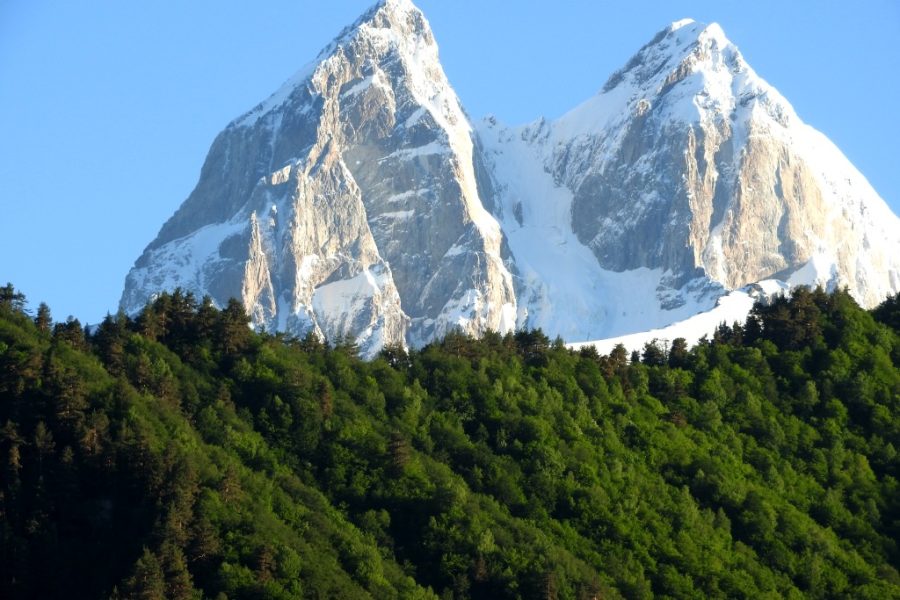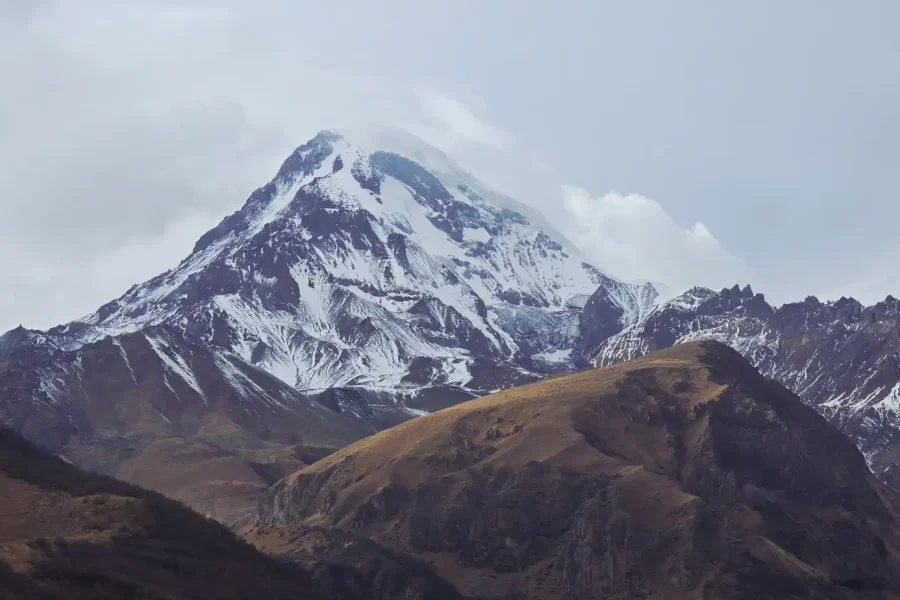Kazbegi National Park: A Symbol of the High Caucasus
Welcome to Kazbegi National Park, one of Georgia’s most beautiful and famous protected areas. It is in the stunning Greater Caucasus mountains. This park is centered around the well-known town of Stepantsminda (formerly Kazbegi). It has a dramatic landscape of high peaks, deep gorges, and alpine meadows, all dominated by the huge, ice-covered Mount Kazbek (Mkinvartsveri), which rises more than 5,000 meters.
A Place of Glaciers and Gorges
Kazbegi National Park was set up to protect this one-of-a-kind high-mountain ecosystem. It is a safe place for rare animals and a great place for hikers, climbers, and nature lovers. The Tergi (Terek) River has carved the dramatic Dariali Gorge and is the main feature of the park’s landscape. Other beautiful areas include the Truso and Sno Valleys. The land goes from birch and pine forests on the lower slopes to huge sub-alpine and alpine meadows full of wildflowers in the summer. Then it turns into rocky moraines, glaciers, and snow that never melts.
Where Nature and Legend Meet
The park has a lot of history and culture in addition to its natural beauty. The famous 14th-century Gergeti Trinity Church, which is a symbol of Georgia, sits on a hill with Mount Kazbek in the background. The historic Georgian Military Highway runs through the area. For centuries, it has been an important link between the North and South Caucasus. The park is an unforgettable place where raw, powerful nature meets ancient stories and deep cultural heritage.
Park Overview at a Glance
Official Name:
Kazbegi National Park (ყაზბეგის ეროვნული პარკი). It is part of a bigger system that has a Protected Landscape and a number of Natural Monuments.
Protected Area Type:
National Park (IUCN Category II). It protects high-mountain ecosystems, glaciers, and rare species while still allowing for tourism that doesn’t harm the environment.
Established:
Originally set up as a reserve in 1976, it was later turned into a National Park in its current form.
Managing Body:
The Georgia Agency of Protected Areas (APA).
Getting to Kazbegi National Park
Location:
In the Kazbegi Municipality, in the Mtskheta-Mtianeti region of Georgia. Stepantsminda is the main town in the park.
Map/Coordinates:
Around 42°39′ N, 44°38′ E. You can get maps for hiking from the visitor center in Stepantsminda or from the APA website.
Closest Cities/Towns:
The main town near the park is Stepantsminda. It is the starting point for almost everything.
How to Get There:
- By Car/Taxi: The park is easy to get to from Tbilisi via the famous Georgian Military Highway. It takes about three to four hours to get to Stepantsminda by car. Along the way, you’ll pass the Zhinvali Reservoir, the Ananuri Fortress, and the Gudauri ski resort.
- Public Transport: Marshrutkas (minibuses) run often from Didube Station in Tbilisi to Stepantsminda. This is a very common and cheap way to get to the area.
Closest Airport:
The airport in Tbilisi is called Tbilisi International Airport (TBS).
Landscape and Geography
Area:
The National Park is more than 78,000 hectares big.
Topography:
The Greater Caucasus has very high peaks, which make the area very mountainous. Mount Kazbek (5,054 m) is the most important feature of the landscape. It has deep river gorges (Dariali, Truso), glaciers, moraines, and steep rocky slopes. There are also alpine and sub-alpine meadows.
Geology and Key Features:
Mount Kazbek, which is a dormant stratovolcano, is in this area. Some of the most important things to see are the Gergeti Glacier, the Truso Valley with its mineral springs and travertines, and the famous viewpoint at the Gergeti Trinity Church.
Hydrology:
The Tergi (Terek) is the main river. It flows north into Russia. It gets water from many smaller rivers, streams, and melting glaciers. There are a lot of mineral water springs, especially in the Truso Valley.
Climate:
The weather in the high mountains is very bad. The winters are long, cold, and snowy, which makes it hard to get around in many places. June to September is summer, which is short and cool. It rains a lot and the weather changes quickly. Even in the summer, nights are cold.
Why is Kazbegi National Park Important?
Reason for Designation:
To protect the Central Caucasus’s unique high-mountain ecosystems, which include its glaciers, native plants, and rare animals like the East Caucasian Tur. It also wants to protect the famous cultural landscape and encourage responsible ecotourism.
Key Values:
A peak over 5,000 meters high stands out in these stunning, dramatic landscapes. Important habitat for large birds of prey and rare hoofed animals. Glaciers are an important source of water. A famous place to go trekking, climbing, and learning about other cultures. The famous Gergeti Trinity Church is a place of great cultural value.
International Recognition:
It is likely a member of the Emerald Network and is part of the Caucasus biodiversity hotspot.
Flora and Fauna: The Park’s Natural World
Ecosystems and Habitats:
Altitude has a big effect on habitats. For example, there are sub-alpine forests (birch, pine), dense rhododendron thickets, huge alpine meadows, and high-altitude rock and ice zones.
Key Plant Species:
Litvinov’s Birch and Caucasian Pine are the main trees in sub-alpine forests. Caucasian Rhododendron is common above the tree line. In the summer, alpine meadows are full of colorful wildflowers. Lichens and mosses that can live in very harsh conditions are found at higher altitudes.
Key Animal Species:
- Mammals: The East Caucasian Tur, a wild goat, is the park’s symbol for mammals. Chamois, Brown Bear, Wolf, and Eurasian Lynx are also important species.
- Birds: A great place to go birdwatching. The Lammergeier (Bearded Vulture), Griffon Vulture, Golden Eagle, Caucasian Snowcock, and Caucasian Black Grouse are some of the most important species.
Endangered/Rare Species:
The IUCN says that the East Caucasian Tur is “near threatened.” The Lammergeier and other big birds of prey are rare and protected.
Planning Your Visit
Visitor Center:
Yes, there is a modern and helpful visitor center in Stepantsminda. It has maps, information about trails and the weather, and can help you find guides and places to stay.
Hours and Seasons:
The best time for tourists to come is from June to September, when they can hike and see the sights. Only experienced mountaineers or ski tourers can go in the winter (November to April). The weather can change very quickly at any time of year.
Entrance Fees and Permits:
Ask the APA about their current rules. Most of the time, entry is free. You need a permit from the Border Police to hike near the Russian border, like in parts of the Truso Valley or up Mount Kazbek.
Trails and Routes:
- Gergeti Trinity Church: The most famous short hike (or drive) is the one from Stepantsminda. It has great views.
- Gergeti Glacier: A hard hike that takes all day and goes past the church to the base of Mount Kazbek.
- Truso Valley: A beautiful and easy walk or drive through a valley famous for its mineral springs and deserted villages.
- Juta and Chaukhi Pass: A beautiful hike from the village of Juta to the dramatic Chaukhi mountain massif, which is often called the “Georgian Dolomites.”
Activities:
Hiking, trekking, climbing Kazbek, birdwatching, taking pictures of landscapes, horseback riding, and seeing cultural sites.
Accommodation:
Stepantsminda has a lot of different places to stay, from cheap guesthouses to fancy hotels. Staying in a guesthouse is a great way to experience local hospitality.
Safety Advice:
- Weather: Even on a sunny day, you should always be ready for cold, rain, and strong winds. The weather in the mountains changes quickly.
- Altitude: There is a risk of altitude sickness, especially on higher trails. Get used to the weather and drink a lot of water.
- Trails: Only walk on marked trails. Crossing glaciers and rivers can be very dangerous. For hard routes, hire a professional guide.
- Border Zone: Before you enter a border zone, make sure you have the right permits and your passport.
Park Rules and Regulations
Code of Conduct:
Follow the rules of Leave No Trace. Be careful with the delicate alpine environment. Don’t bother animals. Respect the religious sites and customs of the area, like the Gergeti Trinity Church.
Prohibitions:
Hunting is not allowed at all. You can’t always light fires, so use camping stoves instead. Don’t camp close to places of worship. You might need a permit to fly a drone. Do what the rangers and Border Police tell you to do.
Conservation and Management
Managing Body:
The APA runs the park through the Kazbegi National Park Administration. There are rangers who patrol the area.
Conservation Efforts:
Pay attention to keeping an eye on and protecting important species like the East Caucasian Tur. Managing a lot of tourists so that they don’t hurt the environment too much. Taking care of trails and building infrastructure for tourism that will last.
Threats and Challenges:
Too many tourists in popular places like Gergeti, which causes trails to erode and trash to pile up. Building without rules. Possible conflict between people and animals. Keeping visitors safe in a dangerous place.
Historical and Cultural Significance
A Brief History:
People have lived in this area for hundreds of years. It used to be called Khevi. The Georgian Military Highway has been an important road since ancient times. Saint Stephen, a monk who built a hermitage here, gave Stepantsminda its name. Mount Kazbek is very important in Georgian myths and stories.
Cultural Importance:
The Gergeti Trinity Church (Tsminda Sameba) is a very important religious and cultural symbol for Georgia. The Greek myth of Prometheus and the Georgian legend of Amirani both say that they were chained to Mount Kazbek as punishment for going against the gods.
Interesting Facts About Kazbegi
Unique Features:
- Mount Kazbek, one of the highest peaks in the Caucasus, is the most important part of the area.
- Home to the world-famous Gergeti Trinity Church, which is one of the most beautiful churches in the world.
- It’s a crucial habitat for the East Caucasian Tur, a type of wild goat that lives only in the eastern Caucasus mountains.
- The famous mountain road, the historic Georgian Military Highway, goes right through the area.
- People know the Truso Valley for its colorful travertine deposits and bubbling mineral water springs.













Leave a review